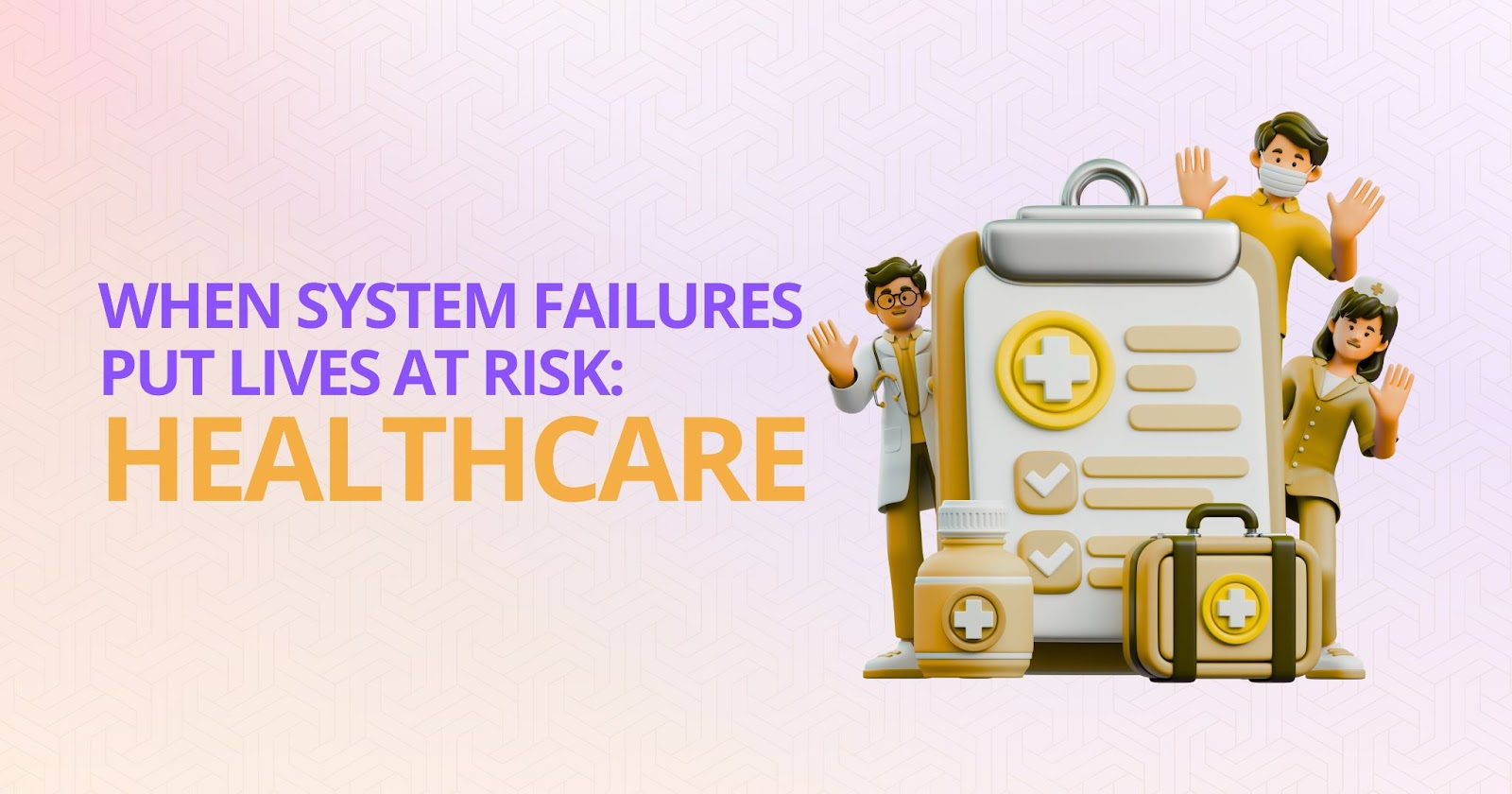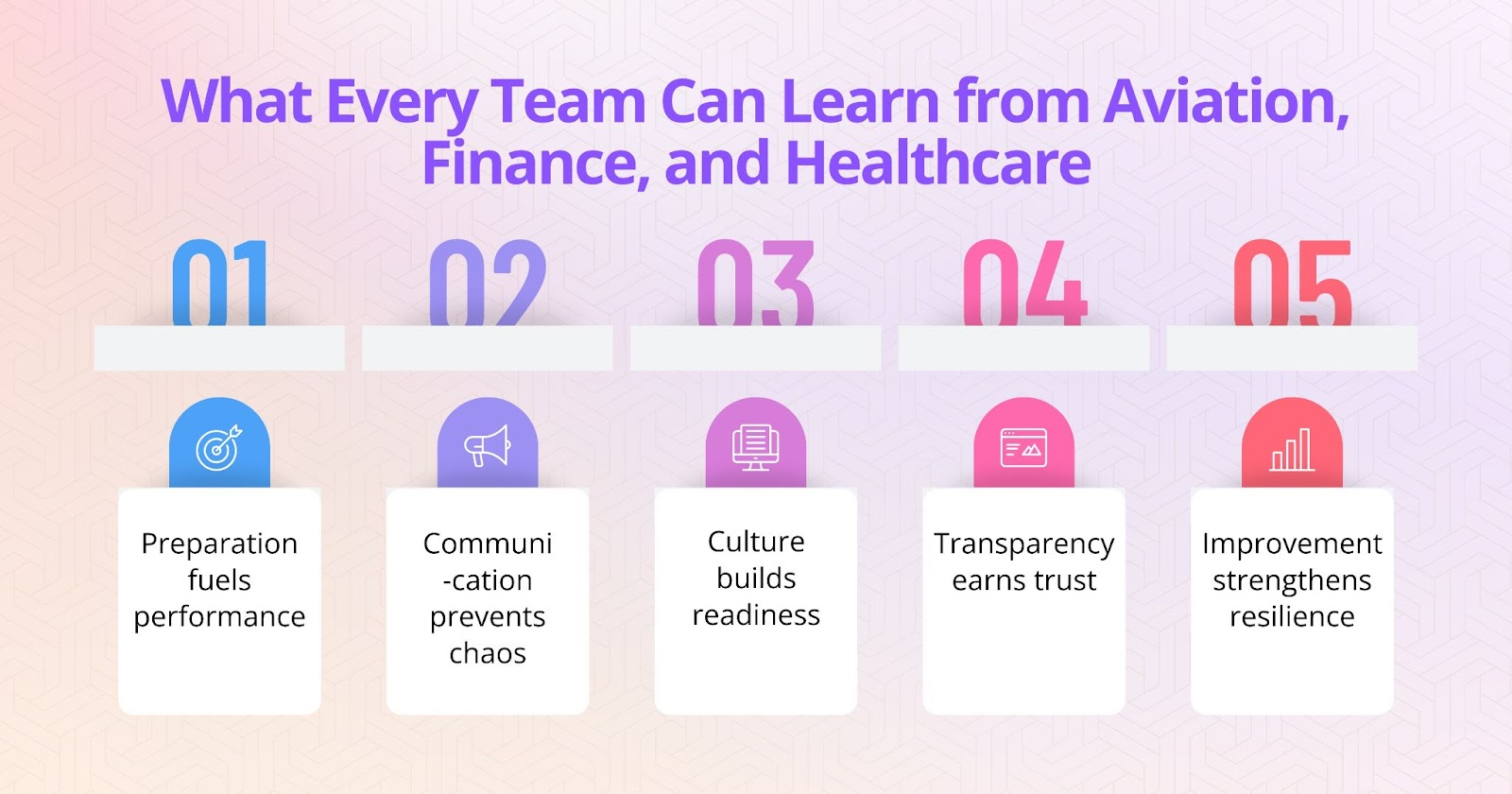When a system fails, a breach occurs, or lives are suddenly at risk, incident response determines how fast an organization can recover and how much damage can be prevented. In aviation, finance, and healthcare, those few minutes between detection and decision can define outcomes measured not just in dollars but in trust, safety, and reputation.
While each sector faces distinct threats, from flight system malfunctions to ransomware or insider fraud, the discipline of incident response follows a universal pattern: preparation, detection, containment, recovery, and learning. The world’s most regulated industries have refined this process over decades, and their lessons are invaluable for any business building resilience today.
Key Takeaways:
- Preparation saves time, trust, and lives through regular training, simulations, and clear playbooks that build true readiness
- Clear roles and fast communication prevent confusion and reduce the impact of any crisis
- Compliance and documentation turn accountability into trust across aviation, finance, and healthcare
- A strong culture of transparency and learning transforms every incident into an opportunity to improve
- AI and automation drive modern resilience by helping teams prevent issues before they escalate
What Incident Response Really Means
Incident response is the structured approach organizations use to manage and resolve security, operational, or safety incidents across sectors like aviation, finance, and healthcare. It is not just about reacting but about preparing for the inevitable. In each of these high-stakes industries, a clear response plan can mean the difference between rapid recovery and lasting damage.
A strong program covers five core stages:
- Preparation: Building playbooks, training teams, and identifying critical assets at risk such as aircraft systems, financial data, or patient records.
- Detection and Analysis: Monitoring for anomalies whether flight data irregularities, unusual transaction patterns, or suspicious access to medical files and confirming incidents quickly.
- Containment and Eradication: Isolating the source of disruption to prevent escalation such as grounding affected aircraft, freezing compromised accounts, or disconnecting infected hospital systems.
- Recovery: Restoring operations to a stable state ensuring systems are secure and compliant with aviation regulations, financial standards, or healthcare privacy laws.
- Post Incident Review: Documenting lessons learned to strengthen defenses, improve coordination, and prevent recurrence across teams and departments.
In aviation, finance, and healthcare, every successful response depends on three factors: clarity of roles, speed of communication, and a culture of accountability. When these align, resilience becomes part of the organization’s identity.
Aviation: High-Reliability Response in the Sky

Aviation operates in one of the most unforgiving environments on earth. Every decision, from pre-flight inspection to midair communication, is governed by precision and timing. When an incident occurs, whether it involves mechanical failure, human error, or cyber interference, the industry’s response must be immediate, structured, and verifiable. There is no margin for confusion.
The aviation sector manages risks through a deeply embedded Safety Management System (SMS) framework that emphasizes proactive hazard identification and continuous improvement. Airlines, airports, and regulators collaborate closely to ensure that lessons from even the smallest anomaly become part of a global safety culture.
Common Types of Incidents in Aviation
Aviation incidents cover a wide range of scenarios that test both technical and human systems. Some of the most frequent include:
- Mechanical and technical failures such as engine malfunctions, hydraulic issues, or instrument faults.
- Operational incidents like air traffic miscommunication or maintenance oversight.
- Cybersecurity breaches targeting airline databases, flight management systems, or airport operations.
- Environmental factors such as bird strikes, weather disruptions, or volcanic ash interference.
Each type demands a unique response plan, but the underlying principles of containment, investigation, and prevention remain consistent across all aviation operations.
Building a Culture of Preparedness
What sets aviation apart is its deeply ingrained culture of preparation. Every pilot, engineer, and controller is trained to handle abnormal situations through simulation and standardization.
Key practices that define aviation readiness:
- Scenario simulations and recurrent training ensure every possible failure is rehearsed in advance.
- Checklists and cross-verification procedures prevent errors under pressure and ensure accountability at every level.
- Continuous reporting systems like the Aviation Safety Reporting System (ASRS) encourage transparency and collective learning across airlines.
These protocols create a feedback loop where every near miss becomes a lesson for the entire industry, not just one airline.
Communication and Coordination in the Air and on the Ground
Effective incident response in aviation relies on seamless communication between pilots, air traffic control, maintenance teams, and emergency response units. Each role has predefined escalation paths that eliminate guesswork.
For example, if an aircraft detects a hydraulic fault mid-flight, the crew immediately follows a documented checklist, communicates with air traffic control, and coordinates with ground maintenance to prepare for potential landing support. These actions happen within minutes and are rehearsed countless times in simulation environments.
Regulatory Oversight and Global Collaboration
The aviation industry’s safety standards are maintained through rigorous oversight from organizations such as the Federal Aviation Administration (FAA), the European Union Aviation Safety Agency (EASA), and the International Civil Aviation Organization (ICAO). These bodies enforce strict compliance, conduct investigations, and share global best practices.
This collaboration ensures that data from one region informs safety decisions worldwide. A malfunction reported by an airline in Singapore might lead to an aircraft inspection order for the same model across the United States and Europe within days.
Lessons Other Industries Can Learn from Aviation
The aviation model of incident response provides timeless lessons that extend far beyond the cockpit:
- Standardization prevents confusion. Clear, documented protocols help teams act decisively under pressure.
- Training must be continuous. Practice through simulations ensures instinctive, coordinated responses during real crises.
- Transparency builds trust. Open reporting systems foster accountability and collective improvement.
- Data sharing accelerates safety. When industries collaborate on threat intelligence, everyone becomes more resilient.
Bringing Aviation Principles to Business Resilience
The precision that keeps aircraft in the sky can also stabilize complex organizations on the ground. Businesses that adopt aviation-style playbooks, training, and documentation experience fewer disruptions and faster recovery when incidents strike.
Whether managing a cybersecurity breach, a financial systems outage, or a public health emergency, aviation teaches one powerful truth: preparedness is not a project but a culture. It begins with disciplined systems, grows through practice, and becomes a mindset that turns potential disasters into opportunities to learn and improve.
Finance: Containment Under Pressure

In the financial world, every second carries weight. A brief outage on a trading floor can trigger cascading losses across global markets. A single data breach can shake investor confidence and erase years of brand trust overnight. In this environment, incident response is not just a technical process; it is an essential business function that safeguards both stability and reputation.
Unlike other sectors where operations can pause, financial systems run continuously across multiple time zones. Transactions, fund transfers, and stock trades occur in real time, leaving no margin for delay. When an incident happens, containment must be swift, communication must be clear, and recovery must follow established protocols. In finance, minutes truly equal millions.
The High Stakes of Every Second
Financial institutions operate under constant scrutiny from regulators, clients, and shareholders. Whether it is a cyberattack on a banking system, a compliance failure, or a service outage during peak trading hours, every disruption demands immediate, coordinated action.
The financial industry’s approach to incident response blends technical rigor with regulatory precision. Success depends not only on how fast a breach is contained but also on how effectively it is reported, documented, and communicated to regulators and customers.
Common Incidents That Test Resilience
The financial sector faces diverse incidents that require structured and time-sensitive responses.
- Cybersecurity breaches expose sensitive customer information, credit card data, and internal systems.
- Ransomware attacks may lock trading systems, ATMs, or online banking platforms, halting millions in transactions.
- Insider threats occur when employees misuse authorized access for theft or data manipulation.
- Regulatory compliance incidents result from reporting failures, data mishandling, or breaches of anti-money-laundering controls.
- Operational outages affect payment processing systems, trading networks, or interbank communication during high-volume hours.
Each incident not only disrupts operations but also tests the institution’s ability to maintain customer trust and meet strict regulatory expectations.
Regulatory Pressure and Reporting Requirements
Financial organizations operate under some of the world’s most rigorous compliance frameworks, each designed to protect consumers and ensure accountability.
- PCI DSS (Payment Card Industry Data Security Standard): Governs how credit card data is processed, stored, and transmitted to prevent fraud.
- SOX (Sarbanes–Oxley Act): Mandates financial transparency, internal controls, and accurate reporting for publicly traded companies.
- GDPR (General Data Protection Regulation): Sets strict rules for collecting, processing, and protecting personal data within the European Union and beyond.
- ISO 27001: Defines international standards for establishing and maintaining an effective information security management system.
Regional laws like the New York Department of Financial Services Cybersecurity Regulation (NYDFS) and the Digital Operational Resilience Act (DORA) in the European Union further require financial institutions to report major cybersecurity incidents within tight timeframes.
Compliance is not a bureaucratic burden; it is a trust mechanism. During an incident, firms must maintain detailed audit trails, document every decision, and demonstrate accountability at every step. Even if technical recovery succeeds, inadequate documentation can lead to fines or loss of credibility.
How Financial Teams Respond Under Pressure
When an incident unfolds on the trading floor, every action is governed by precision and communication. A mature response process typically includes:
- Immediate triage to determine the scope and severity of the issue.
- Containment and isolation to limit impact, such as freezing affected accounts or disabling compromised servers.
- Internal escalation to notify cybersecurity, compliance, and executive teams in parallel.
- External coordination with regulators, law enforcement, and external vendors to maintain transparency.
- Customer communication to provide timely and accurate updates, maintaining trust even during disruption.
Many financial firms use dedicated command centers or “war rooms” that activate during crises. These centralized hubs bring together leaders from IT, legal, compliance, and communications to make rapid, aligned decisions based on verified intelligence.
Culture of Continuous Monitoring
Modern finance depends on constant vigilance. Real-time monitoring systems powered by artificial intelligence and behavioral analytics continuously scan transactions and network activity for anomalies. Security operations centers (SOCs) operate around the clock, analyzing alerts and escalating threats as soon as they appear.
However, technology alone cannot guarantee resilience. The greatest strength lies in collaboration. Financial institutions that foster strong coordination between IT, compliance, and risk management teams respond faster and recover more effectively.
Lessons Other Industries Can Learn from Finance
The financial sector offers essential insights for every organization aiming to strengthen its resilience.
- Speed and transparency protect reputation. The faster an organization identifies, contains, and communicates about an issue, the smaller its impact on customers and investors.
- Segregation of duties limits exposure. No single person should have unchecked control over critical systems or data.
- Invest in detection as much as defense. Early detection systems are often the difference between a contained event and a public crisis.
- Documentation builds credibility. Comprehensive audit trails and compliance reports demonstrate accountability and professionalism.
Turning Crisis into Confidence
The financial industry shows that the true goal of incident response is not only containment but confidence. When teams respond with speed, transparency, and structure, clients see reliability rather than failure.
Every business, regardless of industry, can apply these principles. Build systems that detect threats early, empower teams to act decisively, and treat every incident as an opportunity to strengthen trust. In finance and beyond, preparedness turns pressure into proof of resilience.
Healthcare: Incident Response When Lives Depend on It

In healthcare, incident response extends far beyond data recovery and technical repair; it can determine whether patients receive care on time or face life-threatening delays. Hospitals, clinics, and laboratories operate in a complex ecosystem where digital systems and human lives are deeply connected. From electronic medical records to networked infusion pumps, a single disruption can affect thousands of patients in minutes.
Unlike finance or aviation, where downtime mainly impacts money or logistics, healthcare incidents directly affect human well-being. When systems fail, clinicians lose access to patient histories, pharmacies cannot verify prescriptions, and diagnostic equipment may go offline. Every second counts, making healthcare one of the most time-sensitive environments for incident response.
Common Incidents in the Healthcare Environment
Healthcare organizations face a growing range of threats due to the integration of medical technology, digital records, and strict privacy regulations.
- Ransomware attacks can lock entire hospital systems, forcing staff to revert to manual record-keeping and delaying critical treatment.
- Data breaches expose sensitive patient information, including personal details, medical histories, and insurance records.
- Malfunctioning medical devices connected to hospital networks can disrupt monitoring or medication administration.
- Supply chain incidents impact access to pharmaceuticals, medical equipment, or laboratory systems.
- Human error in managing software updates or handling patient data can trigger outages or accidental data loss.
Each type of incident carries both operational and ethical consequences. A delay in restoration could mean a missed diagnosis or postponed surgery, which highlights why preparation and coordination are vital.
The Regulatory Landscape
Healthcare incident response is guided by strict laws and frameworks designed to protect both patients and data integrity.
- HIPAA (Health Insurance Portability and Accountability Act) sets national standards for safeguarding patient health information and mandates breach notifications.
- GDPR (General Data Protection Regulation) enforces strict privacy rules for healthcare institutions operating in or serving patients from the European Union.
- HITECH Act (Health Information Technology for Economic and Clinical Health) enhances HIPAA compliance and requires transparency in breach reporting.
These regulations ensure that healthcare organizations do not only restore systems but also maintain ethical responsibility and legal compliance. Failure to report or document an incident can lead to significant penalties, lawsuits, and a long-term loss of public trust.
Coordinating Response Across Teams
An effective incident response in healthcare depends on close coordination between technical, clinical, and administrative teams.
- Detection and triage help identify which departments and systems are affected.
- Communication with medical teams allows clinicians to switch quickly to contingency procedures when necessary.
- Containment isolates compromised networks or applications from critical operations to prevent further disruption.
- Recovery focuses on restoring system functionality and ensuring patient data accuracy before reactivation.
- Notification ensures that regulators, patients, and stakeholders receive timely and accurate updates.
Some hospitals activate emergency operations centers (EOCs) during large-scale disruptions. These centers serve as a command hub where leadership, IT, and medical teams coordinate real-time decisions to protect patient care.
Communication and Transparency During a Crisis
Healthcare organizations must balance urgency with integrity. Communicating clearly with staff, patients, and the public helps control panic and reinforces confidence. When handled responsibly, even a serious incident can become an example of accountability and professionalism.
Organizations that share verified information early and outline recovery steps maintain more trust than those that withhold details. Transparency, supported by clear communication and quick action, often transforms a crisis into an opportunity to strengthen reputation.
Lessons from Healthcare for Every Industry
Healthcare’s approach to incident response provides valuable insights for all sectors.
- Prioritize people. Every response plan should protect human impact, whether involving patients, employees, or customers.
- Prepare for every scenario. Contingency procedures and manual workflows keep operations running even when technology fails.
- Combine expertise with empathy. The technical response matters, but how teams communicate and support those affected defines long-term trust.
- Train across disciplines. IT, medical, and administrative staff should understand each other’s priorities and processes to coordinate effectively.
From Crisis Management to Continuous Care
In healthcare, resilience is part of patient care. Just as early diagnosis prevents illness, early detection and well-practiced response prevent system failure.
Incident response is not only a technical task but an essential part of clinical operations. Hospitals that conduct regular drills, test recovery systems, and maintain open communication are better equipped to protect both patients and data.
Every organization can learn from this mindset. Preparation, collaboration, and empathy turn crisis response into an extension of care. In healthcare and beyond, saving systems ultimately means saving lives.
Cross-Industry Lessons for Resilient Teams

Aviation, finance, and healthcare face different challenges but share one foundation: preparation saves time, lives, and trust. Their lessons apply to every sector, from manufacturing and logistics to education, retail, and technology.
- Preparation drives performance. The best responses begin before a crisis occurs. Regular training, clear roles, and practiced procedures reduce confusion and speed up recovery.
- Communication controls escalation. Timely, accurate updates between teams and leaders stop small issues from turning into major failures.
- Culture sustains readiness. A workplace that values honesty, accountability, and learning encourages faster reporting and smarter decisions.
- Transparency protects trust. Open communication with customers, regulators, and partners builds credibility, even during setbacks.
- Continuous improvement ensures resilience. Each incident provides insight that strengthens systems and response plans for the future.
These principles apply across industries that depend on reliability and reputation, whether in transportation, energy, education, or technology. Strong preparation, clear communication, and a culture of learning create organizations that recover quickly and earn lasting trust.
Building the Future of Incident Readiness
Resilient organizations no longer wait for failure to act. The most advanced teams treat incident response as an evolving discipline that blends intelligence, collaboration, and preparation into everyday operations. Across aviation, finance, and healthcare, the message is clear: resilience is not about reacting faster but about designing systems that anticipate and prevent disruption before it begins.
Modern incident readiness is proactive. It uses automation to handle complexity while empowering people to focus on decisions that matter most. Artificial intelligence enhances detection, coordination, and learning, helping teams recover faster and refine processes with every incident. The future belongs to organizations that turn reliability into a strategic advantage, where every challenge becomes a lesson that strengthens performance.
At Rootly, we help teams move from manual firefighting to intelligent prevention with AI native automation that helps modern teams prevent and resolve incidents faster.
Get started for free or book a demo to see how Rootly transforms incident management into a competitive advantage.
.avif)























